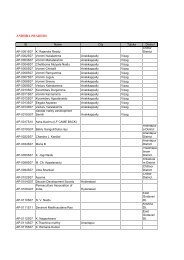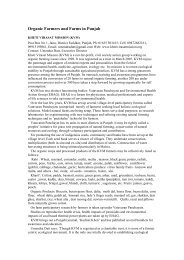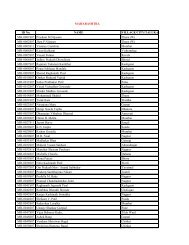Western Ghats Kokum Foundation - Organic Farming Association of ...
Western Ghats Kokum Foundation - Organic Farming Association of ...
Western Ghats Kokum Foundation - Organic Farming Association of ...
Create successful ePaper yourself
Turn your PDF publications into a flip-book with our unique Google optimized e-Paper software.
alternate day. (6) After 21st day, siphon or decant the clear wine leaving behind the solid<br />
residue, which is to be discarded. Rack after 48 hours in a large jar and bottle. Rack again, if<br />
needed, and top up the bottles for maturing the wine. Sweeten with sugar, as per taste.<br />
Improved method developed by Dr. John Carmo Rodrigues.<br />
1. The most important step is to sanitize all containers and equipment used in wine<br />
making, especially if they are being re-used. Use only food grade stainless steel and<br />
glass containers. Wash thoroughly, sun dry, treat with steam <strong>of</strong> boiling water.<br />
2. Boil water and cool. Wash the fruit in cooled lukewarm water. Drain the water over a<br />
stainless sieve and dry the fruit.<br />
3. Discard all green and over-ripe fruits with discoloured pulp. Mechanically split open<br />
the shell <strong>of</strong> just ripe <strong>Kokum</strong> fruits and separate the seed and pulp from the<br />
rind.<br />
4. Put the rind pieces in a steel sieve and add sugar in order to extract the juice from the<br />
rind by reverse osmosis. Keep the container covered during the process.<br />
5. When all the juice is collected, measure it, transfer this to another sanitized<br />
container and add about 2 g pectinase enzyme per litre <strong>of</strong> juice. Stir well at periodic<br />
intervals. Cover the mouth <strong>of</strong> the container by cloth so that air passes freely but<br />
prevents flies from settling on the mixture. Allow the mixture to stand for a day till<br />
all the pectin in the juice is inactivated and settles down.<br />
6. Filter or siphon the contents into another sanitized container.<br />
7. Adjust the Specific Gravity <strong>of</strong> the juice to be in the range <strong>of</strong> 1.09 to 1.160 by adding<br />
sugar. Specific gravity <strong>of</strong> 1.09 and below will give a dry wine and 1.160 and above, a<br />
sweet wine. Values in between will give a semi dry wine.<br />
8. Adjust the acidity <strong>of</strong> the juice to be in the range <strong>of</strong> 3.1 to 3.4 pH by using citric acid if<br />
necessary.<br />
9. Activate the dry yeast by putting it in a dilute solution <strong>of</strong> sugar in warm water. When<br />
bubbling, add this to the filtered juice. Use red wine yeast as the strain <strong>of</strong> yeast will<br />
determine the quality <strong>of</strong> the wine.<br />
10. Stir the mixture vigorously at periodic intervals till the production <strong>of</strong> bubbles<br />
indicates the beginning <strong>of</strong> aerobic or primary fermentation. Cover the mouth <strong>of</strong> the<br />
jar with a cloth to allow free flow <strong>of</strong> oxygen. Cessation <strong>of</strong> the bubbles marks the end<br />
<strong>of</strong> the primary fermentation. This may take 10 to 12 days.<br />
11. Filter or siphon the contents into another sanitized jar. Put a fermentation cork and<br />
allow the contents to stand for a period <strong>of</strong> another 15 days till all the sediments<br />
settle down. This represents the end <strong>of</strong> the "secondary or anaerobic fermentation".<br />
12. When all the sediments have settled down, transfer the fresh wine into bottles, seal<br />
tightly and allow the wine to age for six months. The wine is now ready to be served.<br />
Marketing <strong>of</strong> home-made wines made from <strong>Kokum</strong> has been promoted by the<br />
Botanical Society <strong>of</strong> Goa, and the <strong>Western</strong> <strong>Ghats</strong> <strong>Kokum</strong> <strong>Foundation</strong> through the Konkan<br />
Fruit Fest, annually since 2003. Inspired by the presentation by Ms. Cristina Micheloni on<br />
‘OrWine’ at the East Asia Conference, 2009, at Seoul-Korea, conscious efforts led by Dr. John<br />
Carmo Rodrigues [Ph D in microbiology] to make the <strong>Kokum</strong> wine-making process entirely<br />
organic began in Goa during the summer <strong>of</strong> 2010.<br />
92<br />
Resource Book on <strong>Kokum</strong> (Garcinia indica Choisy)<br />
<strong>Western</strong> <strong>Ghats</strong> <strong>Kokum</strong> <strong>Foundation</strong>, Panaji - Goa





